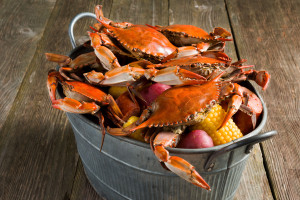The devastating Chesapeake blue crab collapse
By Gerald W. Winegrad
Recent news on Chesapeake Bay blue crabs accurately covered the severe drop in the numbers of crabs but did not accurately portray the weak response by state fishery managers, the urgency of enforcement and need for greater curbs on harvest pressure.
The data document a radical decline in crab numbers — the lowest ever recorded. This nadir was reached after crab numbers dropped by 32 percent in 2020 and an additional 30 percent in 2021. We are now at less than one-third of the population of 30 years ago. Juvenile crabs declined three years in a row and in five of the past six years, denoting a serious recruitment failure likely leading to even fewer crabs.
The radical decline in male crabs to the lowest recorded level is of grave concern. But the linkage to overall crab abundance from low sperm availability has been overemphasized. One biologist noted the sperm problem “might” account for a 5 to 10 percent decline in fertilized eggs. The cause of precipitous decline in crab numbers goes well beyond such egg declines.
Other factors affecting crab numbers include a failure to restore bay grasses (crab nurseries), polluted waters and invasive species. But the harsh reality is that the increasing harvest pressure triggered by astronomical crab prices is the only readily controllable fix to prevent an imminent crab collapse. However, all harvest restrictions — both existing and new — are rendered meaningless in Maryland because of nearly nonexistent enforcement. Tragically, the Maryland Department of Natural Resources (DNR) has chosen a laissez-faire approach to enforcement, allowing crabbers to act with impunity.
The new regulations set limits on male harvest only in August and September, and the reduction is only 5 percent, not the 15 to 25 percent alleged to be hurting watermen. Any reduction would occur only if the regulations were fully enforced. Limiting a commercial crabber to 15 bushels of male crabs six days a week will do little to resolve the problem. Certain licensees with deckhands can take 30 bushels per vessel daily. With the paucity of crabs, such limits might often be out of reach.
The closing of harvest on Nov. 30 instead of Dec. 15 is of negligible impact and only reinstates the closure date that existed for years before Maryland Gov. Larry Hogan (R) came into office and some watermen wanted the season extended.
In 2008, the Maryland and Virginia governors succeeded in having the crab fishery declared a natural disaster by the federal government to shake loose $20 million in federal relief for a disaster created by their own mismanagement. The states then committed to a target of 196 million spawning-age female crabs. But female numbers have fallen from 158 million crabs in 2021 to 97 million, less than half of the agreed-upon target. And yet Maryland still will allow up to 64 bushels of females to be taken on one vessel during certain periods. Recreational crabbers have been forbidden from keeping any females for years.
It is critical to understand that DNR enforcement against commercial and recreational crabbers is virtually nonexistent. Catch limits mean little, if anything, without enforcement.
Under Hogan, DNR fisheries regulation has been politicized, and commercial harvesters basically control decision-making despite the science. The most egregious case involved the 2017 firing of crab specialist Brenda Davis, a DNR professional fishery biologist for 28 years.
Her offense? Daring to stand up to a group of commercial crabbers who were trying to persuade her to ease limits on crab harvest. After the crabbers met with Hogan to complain, Davis was fired. This unwarranted dismissal of a professional for doing her job led to legislative hearings and embarrassingly widespread press coverage. The Post headline: “Longtime Maryland official fired after watermen meet with governor.”
This outrageous action came after Hogan criticized DNR restrictions on commercial harvests, which he called a “war on watermen.” This interference with sound fishery management science still affects the morale of fishery biologists and deters proper management.
The states are failing to adopt the necessary measures to turn around the decline of Chesapeake Bay water quality and restore bay grasses. The Hogan administration has a documented failure to enforce environmental regulations especially of the polluting chicken industry, as documented in the Environmental Integrity Project’s “Blind Eye to Big Chicken” report. This leaves no other choice but to impose and enforce greater harvest restrictions to prevent the iconic blue crab from collapsing, as have other mismanaged fisheries including oysters, soft clams, shad and sturgeon.
Gerald W. Winegrad chaired the Maryland Senate’s Environment and Chesapeake Bay Subcommittee and has been a recreational crabber for more than a half-century from Norfolk to Annapolis.